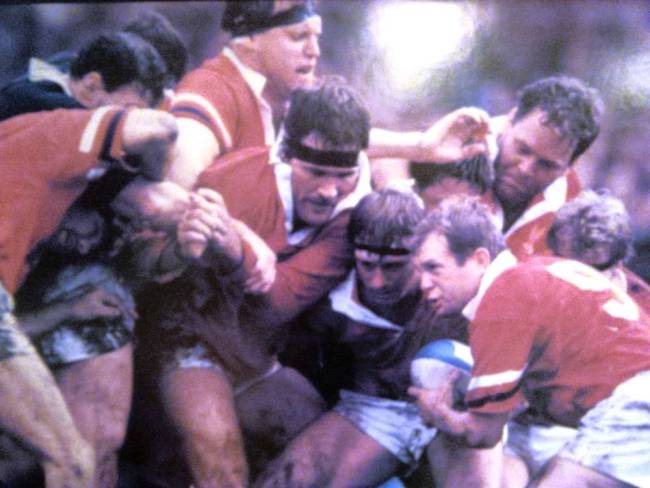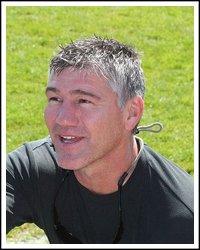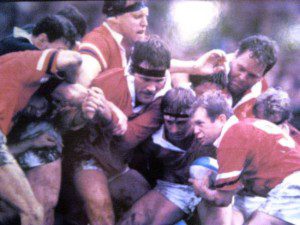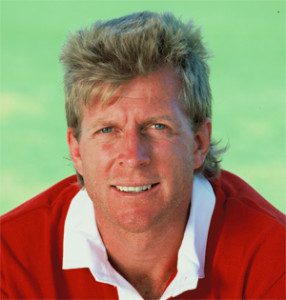
In preparation for the 2015 Rugby World Cup, Rugby Rain Man Collective member Ryan Day will provide a match review and analysis of all the Rugby World Cup games in USA Rugby history.

FT. WAYNE, IN – The first-ever match of American Rugby World Cup history was a 50/50 match going in. The U.S. and Japan had played the year prior and the game ended a draw. With the other two teams in the group being England and Australia, both sides had an idea this would be their only chance for a win.
The Eagles had about as horrible a start as you could imagine. Fly half Joe Clarkson on the opening kickoff did not kick 10 meters, the Japanese owned the initial scrum, Eagle fullback Ray Nelson on a clearing kick off the scrum puts the ball in touch off the side of his foot, Japan won the lineout, went to a maul, Eagles collapsed it giving Japan a scrum, and Japan promptly won a penalty in front of the sticks at the 22 that Japanese center Yoshinaga made to put them up 3-0.
American nerves settle down a bit as they get possession of the ball and run with it. Following a Japanese scrum penalty on the 22, Nelson without a tee, takes an excellent penalty from close to the sideline to level the score. After some back and forth and a couple missed Japanese penalties, the first time a try is threatened occurs off a Japanese lineout that is bobbled by the Eagles. Japanese hooker Fujita kicks a couple grubbers into the try zone but is just beat by Eagle scrum half Joe Saunders who is able to touch it down for a 22 drop. Shortly after, Eagle hooker Everett concedes a penalty when he runs into a tackle and swings his arm into the Japanese tackler in the hit, which is a nice dirty trick, but only if the ref doesn’t see it. From the resulting play, the Japanese backline do the crispest ball play thus far in the match running around the Eagle backs and Japanese wing Taumoefolau is able to score in the corner to put the Cherry Blossoms up 7-3 (tries were 4 points then).
The Eagles show some enterprising play next as after a great clearance kick by Clarkson, Eagle flanker Gary Lambert steals the Japanese lineout, the ball ends up with Eagle center Roy Helu who does an up-and-under caught by the other Eagle center Kevin Higgins inside the Japanese 22. After a few phases stretching the Japanese defense, the ball goes out wide to Eagle wing Mike Purcell who scores the try. Best run of play by the Eagles up to this point. Nelson converts from wide to give the Eagles their first lead of the game at 9-7.

Japan had another penalty kick attempt from close to midfield that they just missed. Eagle discipline was very poor (7-1 in number of penalties), but Yoshinaga was 1 of 5 from his kicks so it was not being punished. Japanese flanker Miyamoto near midfield takes advantage of a not well organized Eagle defense and kicks behind them to make a chase for it, he is tackled by Clarkson who is whistled for interference. Japan takes a quick tap inside the 22 and Yoshinaga spots the gap between Higgins and Purcell to score the try, but again misses his kick and can’t convert.
The Eagles recover the next kickoff and just as happened with the Japanese try earlier, the Eagles are able to make a try. After some good ground gained ruck-to-ruck from Clarkson, Higgins, and Eagle #8 Brian Vizard, the Japanese defense are out of shape, Helu draws in the outside defender, passes to Nelson who takes the gap to score. Unlike Yoshinaga, Nelson is able to convert his own try and at an angle. Nelson for not using a tee had a beautiful form to his placekicking and based only on this game is better than some Eagle placekickers used in recent times. Japan threatens a little before half, but the Eagles hold to go into half ahead 15-11.
To show some things never change, the halftime commentary had Murray Mexted and Bernie Fraser in analysis comment on the smaller size of the Japanese forwards in comparison to the Eagle forwards, and yet they’re still able to move the Eagle scrum around.
Second half started and the teams went back and forth with much less mistakes being made. The first scoring opportunity came and Japan switched placekickers going for their other center Kutsuki. He went sharp right. From the resulting 22 drop, Japan take possession and then launch an up-and-under that they are able to recover and almost score. Ref calls for a 5-meter scrum and the Eagles are able to win a scrum penalty to get them breathing room. Japan get back into the Eagle 22 and again take the penalty kick. At this point, Japan have an 11-3 edge in penalties. Kutsuki makes the kick, getting a perhaps sarcastic cheer from Ballymore to cut the Eagles’ lead to 1. A penalty comes the Eagles’ way on the kickoff and at the 10-meter line near the sideline the Eagles decide to go for posts for some reason. Clarkson takes it and is well short as the Japanese clear.

A lucky break then comes the Eagles’ way. Vizard takes from the back of the scrum and makes a linebreak. As he’s tackled by Japanese fullback Mukai, he sees Lambert in support and throws it back. If Lambert tried to catch, he would’ve knocked on. Instead Lambert kicks the ball on the volley. Taumoefolau tries to kick the ball out for Japan but does not kick it solid, so Lambert comes from behind and touches the ball down before it bounces out for an opportunistic try. Nelson makes the conversion from the sideline bouncing off the crossbar and over. The conversion was important as it put Japan out of range of a converted try at 21-14.
Japan tried to get back in the contest but the Eagles largely kept them out of their end of the field. With ten minutes remaining, Japan draw a penalty when an Eagle is offside at a ruck, but Kutsuki poorly misses the ensuing kick ensuring the Cherry Blossoms would not get within a converted try for a chance to win. Japan finally succeeded with the last play of the game getting a try from a 5-meter scrum as they are able to push the Eagles scrum into the try zone, the ball comes out, and Taumoefolau puts downward pressure on the ball for his second try of the match. The kick is missed and the full time whistle blows, Eagles winning 21-18.
Story of the game was an even contest with poor Eagle discipline which Japan were incapable of punishing when they had plentiful opportunity to do so. Combining their poor 2-for-10 placekicking with the perfect 4-for-4 placekicking of Ray Nelson is the reason the Eagles won. So the Eagles start out their Rugby World Cup account with a hard fought if flawed win. They would have to wait 16 years before they could win again.
USA v Japan – May 24, 1987 – Ballymore – Brisbane, Australia
USA: 1. Rick Bailey, 2. John Everett, 3. Fred Paoli, 4. Kevin Swords, 5. Ed Burlingham (capt.), 6. Gary Lambert, 7. Blane Warhurt, 8. Brian Vizard, 9. Mike Saunders, 10. Joe Clarkson, 11. Gary Hein, 12. Roy Helu, 13. Kevin Higgins, 14. Mike Purcell, 15. Ray Nelson
Japan: 1. Koji Yasumi, 2. Tsuyoshi Fujita, 3. Koji Horaguchi, 4. Toshiyuki Hayashi (capt.), 5. Atsushi Oyagi, 6. Katsufumi Miyamoto, 7. Sinali-Tui Latu, 8. Michihito Chida, 9. Hisataka Ikuta, 10. Seiji Hirao, 11. Shinji Onuki, 12. Eiji Kutsuki, 13. Kojiro Yoshinaga, 14. Nofomuli Taumoefolau, 15. Shogo Mukai
USA-21 (15)
Tries: Purcell, Nelson, Lambert
Conversions: Nelson (3/3)
Penalties: Nelson (1/1), Clarkson (0/1)
Japan-18 (11)
Tries: Taumoefolau (2), Yoshinaga
Conversions: Yoshinaga (0/2), Kutsuki (0/1)
Penalties: Yoshinaga (1/4), Kutsuki (1/3)
My Man of the Match: Ray Nelson, USA
Note: This article has been edited to show that Gary Lambert scored the game-clinching try due to the word of Brian Vizard in the comments.
Well, that’s Lesson 1. Thanks for reading and feel free to comment below. Also, please look for and “Like” our Facebook Rugby Wrap Up Page and follow us on Twitter@: RugbyWrapUp, Junoir Blaber, James Harrington, Jamie Wall, Nick Hall, DJ Eberle, Jake Frechette, Scheenagh Harrington, Jamie Loyd, Cody Kuxmann, Karen Ritter, Audrey Youn, Akweley Okine and Declan Yeats, respectively.

